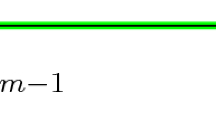Abstract
We consider a Hotelling location game where retailers can choose one of a finite number of locations. Consumers have strict preferences over the possible available store locations and retailers aim to attract the maximum number of consumers. We prove that a pure strategy equilibrium exists if the number of retailers is large enough. Moreover, as the number of retailers grows large, in equilibrium the distribution of retailers over the locations converges to the distribution of consumers’ preferences.
Similar content being viewed by others
Notes
We refer to Fournier and Scarsini (2014) for a recent extensive bibliography on the topic.
References
Balder, E.J.: An equilibrium closure result for discontinuous games. Econ. Theory 48(1), 47–65 (2011). doi:10.1007/s00199-010-0574-6
Barelli, P., Meneghel, I.: A note on the equilibrium existence problem in discontinuous games. Econometrica 81(2), 813–824 (2013). doi:10.3982/ECTA9125
Carmona, G.: Understanding some recent existence results for discontinuous games. Econ. Theory 48(1), 31–45 (2011). doi:10.1007/s00199-010-0532-3
de Castro, L.I.: Equilibrium existence and approximation of regular discontinuous games. Econ. Theory 48(1), 67–85 (2011). doi:10.1007/s00199-010-0580-8
Debreu, G.: A social equilibrium existence theorem. Proc. Natl. Acad. Sci. USA 38, 886–893 (1952)
Downs, A.: An Economic Theory of Democracy. Harper and Row, New York (1957)
Eaton, B.C., Lipsey, R.G.: The principle of minimum differentiation reconsidered: some new developments in the theory of spatial competition. Rev. Econ. Stud. 42(1), 27–49 (1975)
Feldmann, R., Mavronicolas, M., Monien, B.: Nash equilibria for Voronoi games on transitive graphs. In: Leonardi, S. (ed.) Internet and Network Economics, Lecture Notes in Computer Science, vol. 5929, pp. 280–291. Springer, Berlin, Heidelberg (2009). doi:10.1007/978-3-642-10841-9_26
Fournier, G., Scarsini, M.: Hotelling games on networks: efficiency of equilibria (2014). doi:10.2139/ssrn.2423345
Glicksberg, I.L.: A further generalization of the Kakutani fixed theorem, with application to Nash equilibrium points. Proc. Am. Math. Soc. 3, 170–174 (1952)
He, W., Yannelis, N.C.: Discontinuous games with asymmetric information: an extension of Reny’s existence theorem. Mimeo (2014a)
He, W., Yannelis, N.C.: Equilibria with discontinuous preferences. Mimeo (2014b)
He, W., Yannelis, N.C.: Existence of walrasian equilibria with discontinuous, non-ordered, interdependent and price-dependent preferences. Mimeo (2014c)
Heijnen, P., Soetevent, A.R.: Price competition on graphs. Technical Report TI 2014–131/VII, Tinbergen Institute (2014)
Hotelling, H.: Stability in competition. Econ. J. 39(153), 41–57 (1929)
Jackson, M.O., Swinkels, J.M.: Existence of equilibrium in single and double private value auctions. Econometrica 73(1), 93–139 (2005). doi:10.1111/j.1468-0262.2005.00566.x
Kalai, E.: Large robust games. Econometrica 72(6), 1631–1665 (2004). doi:10.1111/j.1468-0262.2004.00549.x
Laster, D., Bennet, P., Geoum, I.: Rational bias in macroeconomic forecasts. Q. J. Econ. 45(2), 145–186 (1999). doi:10.1007/s00355-010-0495-0
Mavronicolas, M., Monien, B., Papadopoulou, V.G., Schoppmann, F.: Voronoi games on cycle graphs. In: Mathematical Foundations of Computer Science 2008, Lecture Notes in Computer Science, vol. 5162, pp. 503–514. Springer, Berlin (2008). doi:10.1007/978-3-540-85238-4_41
McLennan, A., Monteiro, P.K., Tourky, R.: Games with discontinuous payoffs: a strengthening of Reny’s existence theorem. Econometrica 79(5), 1643–1664 (2011). doi:10.3982/ECTA8949
Milgrom, P., Roberts, J.: Rationalizability, learning, and equilibrium in games with strategic complementarities. Econometrica 58(6), 1255–1277 (1990). doi:10.2307/2938316
Monderer, D., Shapley, L.S.: Potential games. Games Econ. Behav. 14(1), 124–143 (1996). doi:10.1006/game.1996.0044
Osborne, M.J., Pitchik, C.: The nature of equilibrium in a location model. Int. Econ. Rev. 27(1), 223–237 (1986). doi:10.2307/2526617
Ottaviani, M., Sorensen, P.N.: The strategy of professional forecasting. J. Fin. Econ. 81(2), 441–466 (2006). doi:10.1007/s00355-010-0495-0
Pálvölgyi, D.: Hotelling on graphs. Mimeo (2011)
Reny, P.J.: On the existence of pure and mixed strategy Nash equilibria in discontinuous games. Econometrica 67(5), 1029–1056 (1999). doi:10.1111/1468-0262.00069
Reny, P.J.: Strategic approximations of discontinuous games. Econ. Theory 48(1), 17–29 (2011). doi:10.1007/s00199-010-0518-1
Rosenthal, R.W.: A class of games possessing pure-strategy Nash equilibria. Int. J. Game Theory 2, 65–67 (1973)
Salop, S.C.: Monopolistic competition with outside goods. Bell J. Econ. 10(1), 141–156 (1979)
Schmeidler, D.: Equilibrium points of nonatomic games. J. Stat. Phys. 7(4), 295–300 (1973). doi:10.1007/BF01014905
Topkis, D.: Equilibrium points in nonzero-sum \(n\)-person submodular games. SIAM J. Control Optim. 17(6), 773–787 (1979). doi:10.1137/0317054
Acknowledgments
The authors thank Clémence Christin, Fabian Gouret, and Giacomo Nannicini for their useful remarks and suggestions. The work of Matías Núñez is supported by the center of excellence MME-DII (ANR-11-LBX-0023-01). The work of Marco Scarsini is partially supported by PRIN 20103S5RN3 and MOE2013-T2-1-158. This author is a member of GNAMPA-INdAM.
Author information
Authors and Affiliations
Corresponding author
Rights and permissions
About this article
Cite this article
Núñez, M., Scarsini, M. Competing over a finite number of locations. Econ Theory Bull 4, 125–136 (2016). https://doi.org/10.1007/s40505-015-0068-6
Received:
Accepted:
Published:
Issue Date:
DOI: https://doi.org/10.1007/s40505-015-0068-6



